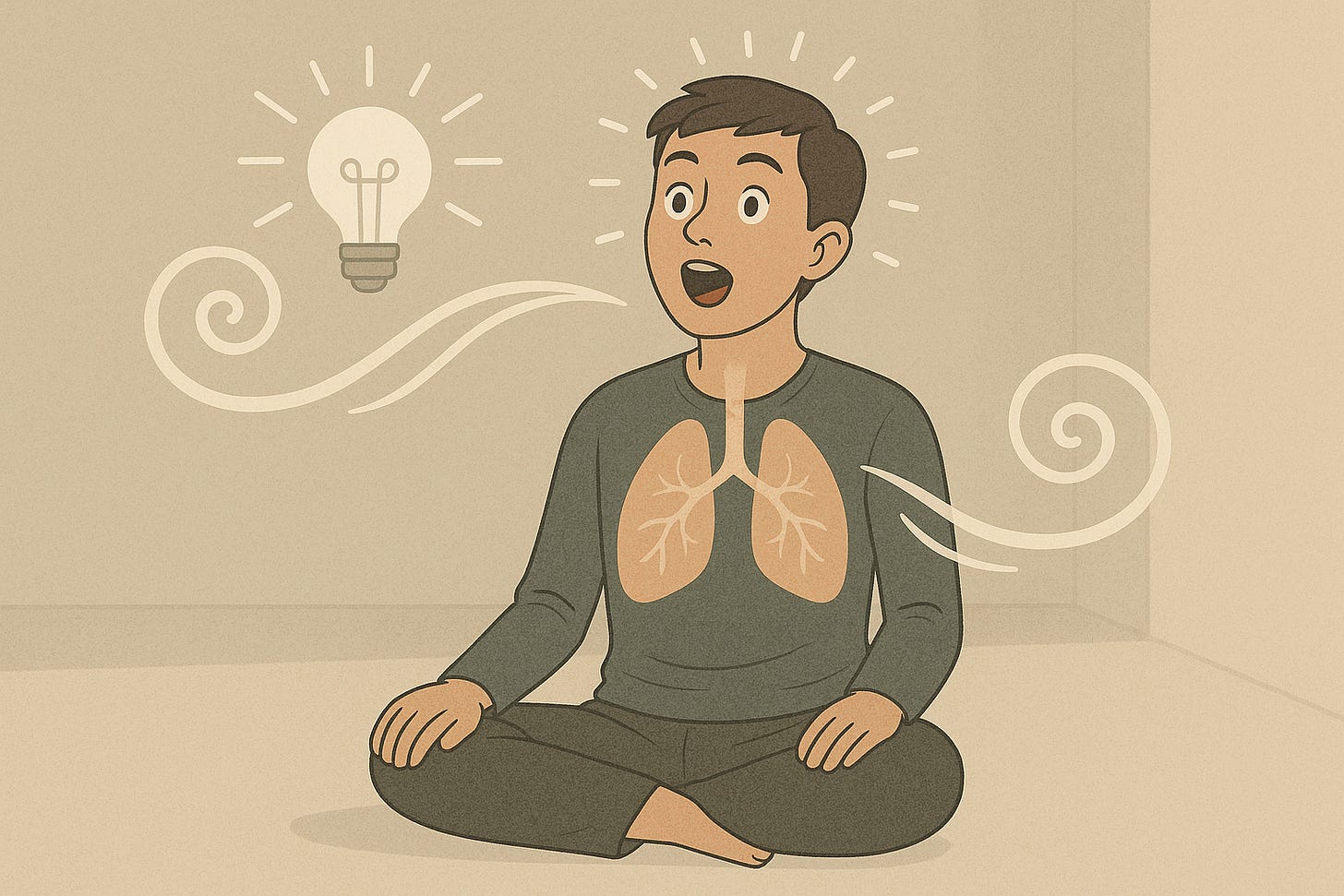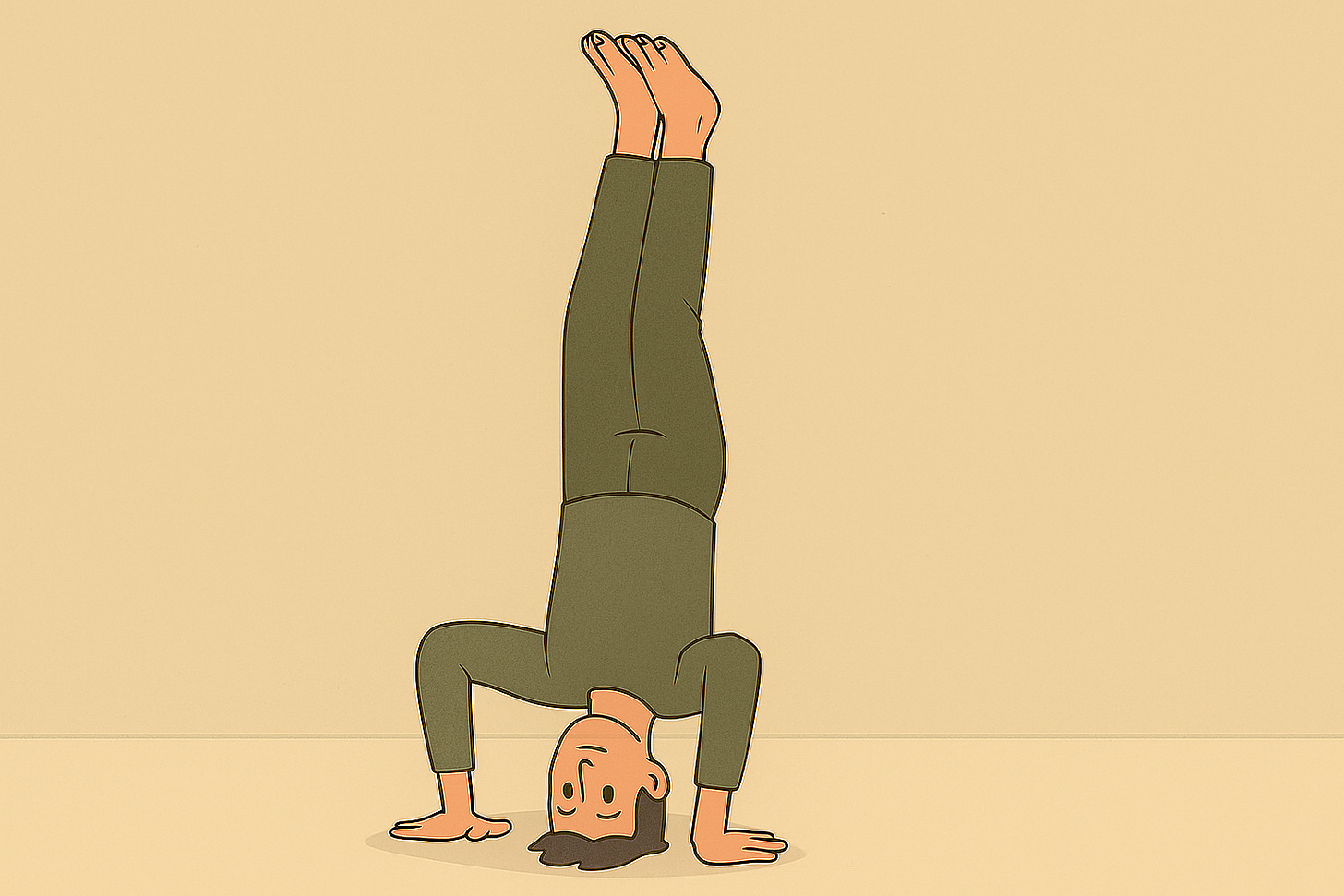Why Such Emphasis on Breath?
Yeah, You Can’t Actually ‘Breathe Into Your Hamstrings’ — But That’s Not the Point
Something that honestly used to bother me when I was first practicing yoga was how frequently teachers mentioned “the breath”.
Often instructors would sit there at the start of class talking about “the breath” as if it was some kind of sacred mystical force.
During class it would get even more abstract.
Feel the stretch in your hamstring, and send your breathe down into it.
— I’m like: ‘Wtf does that even mean?! How do you breath into anything but your lungs?’
Frankly, I’m still suspicious that teacher’s talking so much about the breath just means they don’t have anything else to say.
But truly, that’s ok. Because calling attention to the breath is the most elemental form of yoga instruction and practice. Plain and simple.
Training your attention down onto the breath first is the foundation for accurately perceiving any additional information you might witness during your practice.
This isn’t a hack or some form of esoteric wisdom. It’s just a really, really, really simple way to bring the spotlight of your mind’s focus into your physical experience.
The reason for doing that is also really simple: what good are the sensations that taking an asana creates if you aren’t paying attention to them?
Here are the sutras that brought this full-circle understanding out for me:
30
Vyādhi-styāna-saṁśaya-pramāda-ālasyā-avirati-bhrānti-darśana-alabdhabhūmikatva-anavasthitatvāni cittavikṣepāḥ te antarāyāḥ
The distractions of the mind that act as obstacles (antarāyāḥ) to yoga are:
Vyādhi – illness
Styāna – apathy or mental stagnation
Saṁśaya – doubt
Pramāda – carelessness or heedlessness
Ālasya – laziness
Avirati – craving or over-indulgence in sense pleasures
Bhrānti-darśana – false or delusional perception
Alabdha-bhūmikatva – desire to attain a stage of practice (and failing)
Anavasthitatva – attaining a stage of practice, but failing to maintain
31
Duḥkha-daumanasya-aṅgamejayatva-śvāsa-praśvāsā vikṣepa-sahabhuvaḥ
Suffering (duḥkha), mental depression (daumanasya), trembling of the body (aṅgamejayatva), and irregular breathing (śvāsa-praśvāsa) accompany these distractions.
32
Tat-pratiṣedha-artham eka-tattvābhyāsaḥ
To overcome these, one must practice concentration on a single that-ness (object).
So…
WHAT’S THE ONE OBJECT PRETTY MUCH EVERY LIVING HUMAN IS GUARANTEED TO HAVE TO WORK WITH?
— the breath.
Boom!
In sutras 30 and 31, Patanjali lists out the different obstacles that might get in the way of yoga and the symptoms that arise from these obstacles being present for you.
Let’s take a few and make them relatable through one asana: headstand.
Pramāda – carelessness or heedlessness
You figure since you’ve done headstand 100 times you can let your mind wander a bit, judging the other people you see behind you that aren’t doing headstand, and suddenly you fall, wrenching your neck.
Ālasya – laziness
Headstand is doable for you, but you’re just not into it today and feel like hanging out in wide leg forward fold.
Bhrānti-darśana – false or delusional perception
You can’t do headstand without hurting your neck yet because your upper body isn’t strong enough, but you plan to do it anyways because you believe you are the kind of person who does difficult poses.
Alabdha-bhūmikatva – desire to attain a stage of practice (and failing)
You can’t seem to get headstand right, and are discouraged by it, consistently being annoyed when the teacher offers it during a flow.
Anavasthitatva – attaining a stage of practice, but failing to maintain
You managed to do headstand once, but didn’t continue to strengthen your focus on using the upper body and core in other postures so it doesn’t come easily again.
Any of these may arise as a result:
Suffering (duḥkha) — my neck is in pain
Mental depression (daumanasya) — “I suck at yoga”
Trembling of the body (aṅgamejayatva) — my arms shake in headstand
Irregular breathing (śvāsa-praśvāsa) — I’m trying so hard to do headstand that I’ve lost attention to the breath and it’s no longer conscious.
So as you are moving through your yoga practice, the aim is simply to notice when these things are present.
Why? Because these obstacles are signals that point to underlying imbalances in your physical or mental makeup that, once made aware of, you can begin to change.
But there’s one key factor to remember in this equation!
👉 You must already be paying attention to notice when these things arise.
Of course, if you break your neck in headstand, you’re going to ‘notice’ it…
But yoga was constructed to teach us how to become aware of all the things that led up to the moment where the decision was made to attempt headstand and injury occurred.
I don’t think it’s much of a stretch to state that few of the mistakes we make in life are impossible to prevent. So we can also conclude that the degree to which we are capable of preventing them is derived from level at which we are capable of maintaining our attention on the information that life provides as it unfolds.
So without that primary practice of calling attention down into the space where that information will be arising, what chance do we have of accurately perceiving the true range our hamstring can stretch, whether its a good idea to balance you whole body on your head, or any other aspect of the here and now?
Each posture is a mirror. Gaze into it and see what it shows.
But first, you have to remember to really look. That’s what calling attention to the breath achieves since the breath is always in the body. The experience of breathing cannot ever be experienced anywhere other than here and now because it’s fundamentally dependent on the continual giving and taking of air into the lungs from the surroundings.
You can only witness it one inhale, one exhale at a time.
Beyond ‘preventing mistakes’, this practice enables us to become the more the master of our outcomes, too.
It’s a bit ironic, isn’t it?
The more we learn to detach from the results of our actions, the more we become capable of owning the actions themselves.
And truly, owning the actions fully is the only way to actually do everything we possibly can to assure a given outcome.





